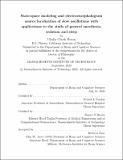State-space modeling and electroencephalogram source localization of slow oscillations with applications to the study of general anesthesia, sedation and sleep
Author(s)
Hotan, Gladia Chork.
Download1227512531-MIT.pdf (12.27Mb)
Other Contributors
Massachusetts Institute of Technology. Department of Brain and Cognitive Sciences.
Advisor
Patrick L Purdon and Emery N Brown.
Terms of use
Metadata
Show full item recordAbstract
General anesthesia, sedation and sleep correspond to distinct physiological states on a spectrum of unconsciousness. Slow oscillations (0.1-1Hz) are a common feature of these unconscious states. It is unclear whether these slow oscillations might have different properties that could relate to mechanistic or behavioral dierences observed in these states. In this thesis we develop novel methods to characterize the dynamic properties and spatial relationships of slow oscillations during general anesthesia, sedation, and sleep. First we analyze the electroencephalogram (EEG) power spectrum in each of these states and nd that slow oscillation power increases with increasing levels of unconsciousness. Next, we perform source localization analysis to characterize the spatiotemporal relationships among distributed cortical generators for the slow oscillation using canonical coherence analysis. We nd that the inherent spatial dispersion of MNE estimates could produce spurious coherence values even when sources were uncorrelated. To improve the accuracy of coherence estimates, we develop an improved source localization method using a state space model for the slow oscillation. This method employs a novel state space representation for oscillatory signals developed by Matsuda and Komaki, combined with an expectation maximization (EM) algorithm to estimate the model parameters in the sensor and source spaces. We demonstrate in simulation studies that this oscillator-EM method improves localization performance as compared to MNE. Finally, we apply the oscillator-EM method to analyze slow oscillations in the propofol, dexmedetomidine and sleep datasets, respectively. We illustrate how the application of this novel state space model and source localization method can elucidate novel properties of slow oscillation dynamics and coherence.
Description
Thesis: Ph. D., Massachusetts Institute of Technology, Department of Brain and Cognitive Sciences, May, 2020 Cataloged from student-submitted PDF version of thesis. Includes bibliographical references (pages 103-109).
Date issued
2020Department
Massachusetts Institute of Technology. Department of Brain and Cognitive SciencesPublisher
Massachusetts Institute of Technology
Keywords
Brain and Cognitive Sciences.